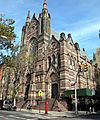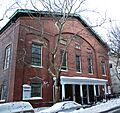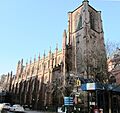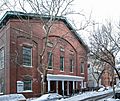Brooklyn Heights Historic District facts for kids
|
Brooklyn Heights Historic District
|
|
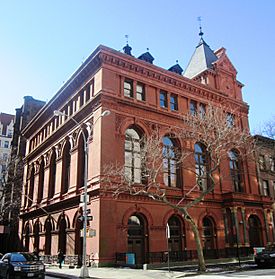
The Brooklyn Historical Society (2013)
|
|
| Location | Bounded by Atlantic Ave., Court and Fulton Sts. and the BQE Brooklyn, New York City |
|---|---|
| Area | 140 acres (57 ha) |
| Architect | multiple |
| Architectural style | Greek Revival, Late Victorian, Gothic |
| NRHP reference No. | 66000524 |
Quick facts for kids Significant dates |
|
| Added to NRHP | October 15, 1966 |
| Designated NHLD | January 12, 1965 |
The Brooklyn Heights Historic District is a special area in Brooklyn, New York City, known for its old and beautiful buildings. It covers a large part of the Brooklyn Heights neighborhood. This district is important because it has been officially recognized as a National Historic Landmark since 1965. It was also named a New York City Landmark in 1965 and added to the National Register of Historic Places in 1966.
This historic district is bordered by Cadman Plaza West (also known as Old Fulton Street) to the north. To the west, you'll find the Brooklyn-Queens Expressway. Atlantic Avenue forms its southern edge. The eastern boundary is a bit wiggly, partly following Clinton and Henry Streets. It's a really well-preserved example of a 19th-century city neighborhood. It's also famous for being one of America's first "commuter suburbs." This means people lived here and traveled to work in another city, like Manhattan.
Contents
Historic Buildings and Churches
The Brooklyn Heights Historic District is home to many important and beautiful buildings. One of them is Grace Episcopal Church, which opened its doors in 1848. It was designed by a famous architect named Richard Upjohn.
Notable Landmarks in the District
You can also find other significant places here. These include Plymouth Church of the Pilgrims, which has a rich history. There's also Our Lady of Lebanon Maronite Catholic Cathedral and the First Presbyterian Church. The First Unitarian Congregational Society is another historic religious building.
The Long Island (Brooklyn) Historical Society building is also within the district. Other notable spots are the Heights Casino and Casino Apartments, Packer Collegiate Institute, and St. Ann's and the Holy Trinity Church. These buildings show off different styles of old architecture.
How Brooklyn Heights Grew
Brooklyn Heights became a popular place to live because of new transportation. In 1814, a ferry service started connecting Brooklyn to Manhattan. This made it easy for people to live in Brooklyn Heights and travel to Manhattan for work or other activities.
A Popular Place to Live
By the mid-1800s, Brooklyn Heights was very well-connected. It had three different ferry services. It was also served by the Brooklyn and Jamaica Railroad. Because of this, it became one of New York's most desired places to live. Later, other areas like Fifth Avenue in Manhattan became even more famous. Some of the streets in Brooklyn Heights are even named after the people who helped develop the area a long time ago.
Images for kids
-
Plymouth Church (1849)









